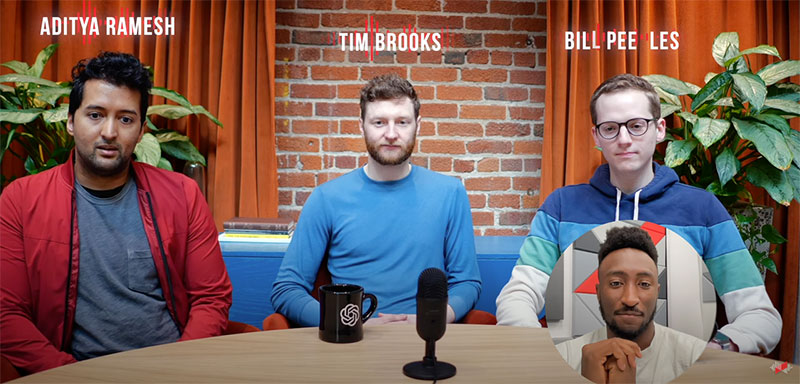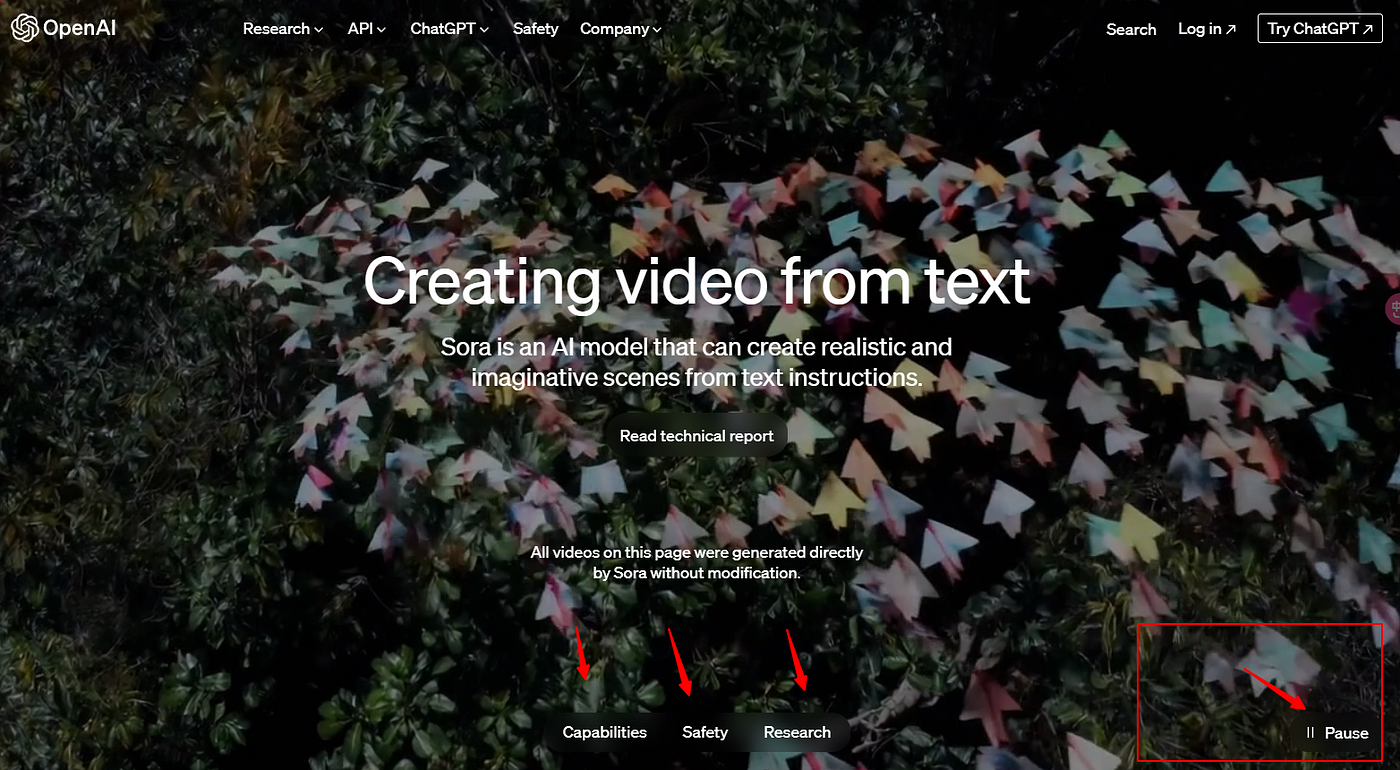Marques Brownlee's Interview on Sora: Insights with Tim Brooks, Bill Peebles, and Aditya Ramesh

In an exclusive interview conducted on March 15th, 2024, tech influencer Marques Brownlee sat down with the core team behind Sora, marking the first in-depth discussion with the brains responsible for what's being hailed as the cutting edge of video generation technology. This pivotal conversation not only peeled back the layers on the mechanics and philosophy driving Sora but also provided a rare glimpse into the collective minds of those at the forefront of AI-driven creativity. As we delve into the intricacies of this groundbreaking model, we stand on the threshold of understanding Sora's potential to redefine video production, content creation, and the very fabric of digital storytelling. Join us as we unpack the insights and revelations from this landmark interview, offering a closer look at the future of video generation through the lens of OpenAI's latest marvel.
Here is the interview video on Youtube:

What Sora Excels At
Photorealism and Video Length Capabilities
Sora has marked a significant step forward in the realm of AI-generated video content, particularly in achieving high levels of photorealism and extending the duration of generated videos. Tim Brooks highlighted, "it definitely excels at photorealism... and the fact that the videos can be so long, up to a minute long, is really a leap from what was previously possible." This advancement opens new doors for creators seeking to produce content that closely mimics the nuances of the real world, offering a canvas that was previously unattainable in the domain of AI-generated visuals.
Current Limitations
Despite its impressive capabilities, Sora is not without its challenges. Tim Brooks candidly shared instances where Sora struggles, noting that "hands in general are a pain point... but also some aspects of physics." He also mentioned the model's difficulty in accurately rendering specific camera trajectories over time, pointing out that if one asks for "really specific, like camera trajectory over time, it has trouble doing that." These areas highlight the complex interplay between the digital representation of the physical world and the current limitations of AI models in perfectly capturing its essence.

Potential Areas for Future Improvement
The Sora team is keenly aware of these limitations and views user feedback as a critical component of the model's ongoing development. The conversation with Marques Brownlee underscores a commitment to addressing these challenges head-on. As Tim Brooks elucidated, one piece of feedback they've received is the desire for "more detailed controls," indicating a future direction where users can exert greater influence over the content generated by Sora.
The Future of AI-Generated Video: Navigating New Frontiers with Sora
Adding Sound to Sora-Generated Videos
The possibility of incorporating sound into Sora-generated videos stands as a significant evolution, poised to amplify the realism and immersion of AI-generated content. Bill Peebles shared insights into this complex undertaking, stating, "It's hard to give exact timelines...we definitely agree, though, that adding in these other kinds of content would make videos way more immersive." This acknowledgment underlines the technical and creative challenges that accompany the integration of auditory elements, suggesting a future where Sora's videos transcend visual boundaries to engage more fully with the human senses.
Leveraging User Feedback for Development
User feedback emerges as a critical driver for Sora's evolution, shaping both its capabilities and applications. Tim Brooks elaborated on the team's approach, revealing, "a big motivation for us...is to get feedback to understand how this could be useful to people." This dialogue between the creators and the community is pivotal, informing the team's research roadmap and ensuring that Sora aligns with the needs and expectations of its users. The feedback mechanism is not just about refinement; it's about co-creating the future of AI video generation with the broader ecosystem of users and creators.
Ethical Considerations and Safeguards
As Sora advances, the imperative to navigate the ethical implications of AI-generated videos becomes increasingly pronounced. Aditya Ramesh touched on the importance of deploying these capabilities responsibly, especially in the context of social media where distinguishing between real and AI-generated content can be challenging. "We want to make sure that these capabilities aren't used in a way that could perpetuate misinformation or something," Ramesh emphasized. The mention of watermarking and provenance classifiers as methods to identify AI-generated content highlights ongoing efforts to establish ethical guidelines and safeguards. These strategies aim to foster transparency and trust, ensuring that as Sora's capabilities grow, so too does its adherence to principles that protect and inform the public.
Creative Possibilities and User Control with Sora

Enhancing User Control through Detailed Controls and Prompt Engineering
The discussion highlighted the importance of detailed controls and the art of prompt engineering in harnessing Sora's capabilities. Tim Brooks emphasized the community's desire for more nuanced command over the generation process, stating, "one piece of feedback we've definitely heard is that people are interested in having more detailed controls." This insight underscores the team's focus on evolving Sora to not just understand but anticipate and fulfill the specific creative intentions of its users, making it a more powerful tool for nuanced storytelling and content creation.
Revolutionizing Content Creation by Lowering Production Barriers
The potential of Sora to lower the barriers to filmmaking, advertising, and general content creation was a focal point of the conversation. The team's work hints at a future where the resource-intensive aspects of video production are significantly mitigated. As Aditya Ramesh articulated, AI could "drastically lower the cost to go from idea to a finished [product]," democratizing content creation and enabling a broader spectrum of voices and visions to be realized and shared. This potential marks a seismic shift in how creative work is produced and consumed, making high-quality video content more accessible to creators worldwide.
Envisioning New Types of Content Beyond Traditional Formats
Perhaps most exciting is the vision for new types of content that Sora could enable. Bill Peebles shared an example of blending two input videos, showcasing Sora's ability to generate content that transcends traditional boundaries and enters the realm of the truly novel. "These kinds of generated videos really do kind of start to feel a bit new relative to what's been possible in the past," Peebles noted, illustrating Sora's potential to not just replicate but innovate, pushing the envelope of what can be imagined and created in digital spaces.
Ensuring Ethical Use of AI in Video Generation with Sora

Distinguishing AI-Generated Videos
A critical aspect of ethical AI use involves clearly marking AI-generated content to prevent confusion and misuse. Aditya Ramesh addressed this concern, outlining the incorporation of watermarking as a fundamental feature of Sora-generated videos. "There's a watermark in the bottom corner of Sora generated videos," Ramesh explained, highlighting an immediate step towards transparency. However, the team is cognizant of the limitations, such as the potential for watermarks to be cropped or altered.

Expanding on this foundational measure, Ramesh introduced the development of provenance classifiers, a more sophisticated approach to identifying AI-generated content. "For Dali three, we trained provenance classifiers that can tell if an image generated by the model, or whether a given image was generated by the model or not," Ramesh noted, indicating a proactive stride towards broader safeguards that extend beyond visual indicators.
Ethical Deployment and Mitigating Misinformation
The ethical deployment of Sora transcends technical safeguards, venturing into the realm of societal impacts and the potential for misinformation. The Sora team is deeply invested in navigating these complexities thoughtfully. Ramesh articulated a vision for a future where AI-generated video tools like Sora are introduced carefully, with a keen awareness of their potential implications on social media and beyond. "We want to make sure that these capabilities aren't used in a way that could perpetuate misinformation or something," Ramesh emphasized, reflecting a commitment to ethical responsibility.
Reaction to Sora and Future Directions
Public and Industry Reception
The Sora team's conversation with Marques Brownlee illuminated the mixed reactions from the public and creative industries toward Sora's unveiling. Tim Brooks discussed the initial response, noting the diversity of feedback: "So it's not currently a product...but really, right now we're in the feedback getting stage." This phase is crucial for understanding how Sora can be fine-tuned to meet the nuanced needs of users across different sectors, from filmmaking to advertising, indicating an open dialogue with the community to refine and enhance Sora's capabilities.
Feedback-Informed Development
Feedback from users and industry experts plays a pivotal role in guiding the development of Sora, shaping its feature set and potential use cases. The team has expressed particular interest in expanding the model's control mechanisms. Tim Brooks highlighted this, saying, "Yeah, one piece of feedback we've definitely heard is that people are interested in having more detailed controls." This acknowledgment points toward a future where Sora could offer more granular creative control, allowing users to specify their vision with greater precision.

Long-Term Vision for Sora and AI-Generated Media
Looking ahead, the Sora team envisions a transformative impact on media creation and consumption. The discussion touched on the potential for AI to lower barriers to content production, democratize creativity, and introduce entirely new forms of media. Bill Peebles hinted at this expansive future, sharing an example of blending video content in novel ways that push the boundaries of traditional media formats. "These kinds of generated videos really do kind of start to feel a bit new relative to what's been possible in the past," Peebles remarked, suggesting a horizon where AI not only replicates but also innovates, offering creators tools to explore uncharted creative territories.
My Reflections on the Sora Interview
Watching Marques Brownlee interview the Sora team gave me profound insights into the intersection of AI and creativity. The discussion highlighted Sora's strengths in creating lifelike videos and the challenges it faces, such as rendering complex movements accurately. Ethical considerations, especially around misinformation, stood out as critical to Sora's responsible deployment. It was particularly interesting to see how the team is using feedback to shape Sora's development, promising more control and creative freedom for users. This interaction between the Sora team and the media, for me, underscored the evolving partnership between AI and human creativity, pointing toward a future rich with potential for innovative storytelling.
